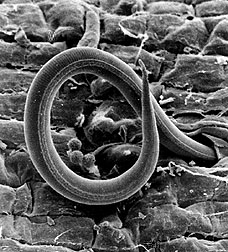This page has been archived and is being provided for reference purposes only. The page is no longer being updated, and therefore, links on the page may be invalid.
|
|
Pepper Lends Its Nematode Resistance to Double-Cropped VegetablesBy Luis PonsJune 23, 2004 The Charleston Belle pepper developed by the Agricultural Research Service continues to impress researchers with its ability to resist major root-knot nematodes afflicting the southern United States. A recent ARS study not only confirmed the effectiveness and heat tolerance of Charleston Belle's resistance gene, but also found that the gene benefits nematode-susceptible vegetables rotated with the pepper. In the study, led by plant pathologist Judy Thies of the ARS U.S. Vegetable Laboratory in Charleston, S.C., Charleston Belle dramatically outperformed its susceptible parent, Keystone Resistant Giant, in field tests. Not only did it repel nematodes, it also protected subsequently planted (double-cropped) susceptible squash and cucumber crops. The research--described in this month's issue of Plant Disease--showed that Charleston Belle exhibited minimal root galling from nematode attack. Charleston Belle also helped the double-cropped cucumber and squash plants produce bigger yields and heavier fruit than when the two were grown following the Keystone variety. The work was conducted at Clemson University's Edisto Research and Education Center in Blackville, S.C., and at the ARS Crop Protection and Management Research Unit in Tifton, Ga. ARS is the U.S. Department of Agriculture's chief scientific research agency. Charleston Belle peppers--released in 1997 by ARS Vegetable Laboratory geneticist Richard Fery--get their resistance from the N gene, which was obtained from a resistant pimiento pepper and placed into Keystone cultivars to create Charleston Belle. The gene controls resistance to three major root-knot nematode species: southern (Meloidogyne incognita), peanut (M. arenaria) and javanese (M. javanica). The pepper's resistance may aid growers who, next year, must fight root-knot nematodes without use of methyl bromide. This pesticide will be banned Jan. 1 because of its ozone-depleting properties. Other, independent studies have shown that nematode-resistant vegetable plants--notably tomatoes--can help shield double-cropped vegetables from nematode attack. In the ARS study, cucumber yields were 87 percent heavier and numbers of fruit were 85 percent higher when grown after Charleston Belle than after Keystone. Squash yields were 55 percent heavier, with 50 percent more fruit. |

